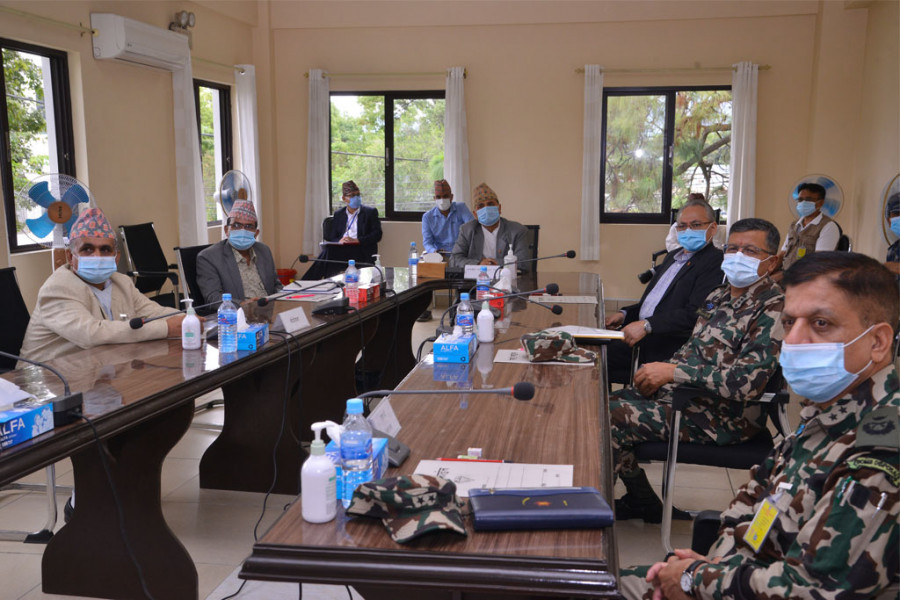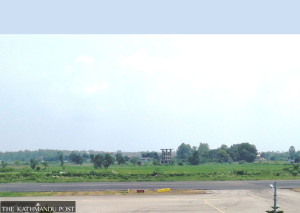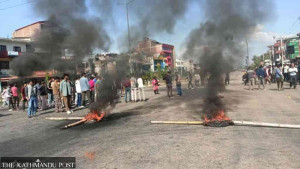National
Given its failure, Covid-19 Crisis Management Centre’s relevance is questioned
The deputy prime minister-led centre’s role is limited to making recommendations to the Cabinet but they are often shot down by the prime minister.
Tika R Pradhan
Before Prime Minister KP Sharma Oli got admitted to Tribhuvan University Teaching Hospital for his second kidney transplant on the evening of March 2, he formed a high-level coordination committee to prepare the country for curbing the spread of the coronavirus.
Deputy Prime Minister and Defence Minister Ishwar Pokhrel headed it.
Then on March 29 when the country was on the sixth day of the nationwide lockdown, the Covid-19 Crisis Management Centre, also headed by the deputy prime minister, was formed as the implementing agency under the High-level Coordination Committee.
On June 10, when the number of cases in the country stood at 4,364, the High-Level Coordination Committee was dissolved and the main responsibility of fighting the pandemic fell on the Covid-19 Crisis Management Centre.
Today, as the number of infections continues to rise and Nepal has overtaken China, where the virus was first discovered, in the number of cases, the Covid-19 Crisis Management Centre is nowhere to be seen. As of Tuesday, the number of cases stands at 90,814 while that of China stands at 85,482.
Its last meeting was on September 29 and it ended without a proper decision.
“After studying the situation, the committee has decided to seek proposals from different ministries,” said Mahendra Guragain, member secretary of the centre, after that meeting.
The proposals that he was referring to were on safety protocols to be followed to check the spread of the virus.
Incidentally, the day Guragain said that marked exactly six months since the Covid-19 Crisis Management Centre was formed.
By the Centre member’s own admission, it has been a gross failure.
“There is a tendency that the decisions of the Centre won’t be implemented,” a minister said after the meeting.
Once Prime Minister Oli became active in public life after his successful surgery, and subsequent recuperation, all decisions regarding the pandemic have been taken by the Cabinet and the centre has now become just an agency to make recommendations.
“After the prime minister recuperated following the kidney transplant, the Cabinet started to take decisions related to Covid-19 so the High-level Coordination Committee was dissolved,” said Education Minister Giriraj Mani Pokhrel, a member of the coordination committee, but not of the Centre.
“But the CCMC, which was formed later, was not given the authority to take decisions but to discuss issues and to make recommendations to the Cabinet.”
The directive committee of the Centre, which is its main committee, is led by Pokhrel and has Home Minister Ram Bahadur Thapa, Federal Affairs and General Administration Minister Hridayesh Tripathi; Industry, Commerce and Supplies Minister Lekhraj Bhatta; Health and Population Minister Bhanubhakta Dhakal, the finance minister, Agriculture Minister Ghanashyam Bhusal, Foreign Minister Pradeep Gyawali, Energy Minister Barshaman Pun; and Culture, Tourism and Civil Aviation Minister Yogesh Bhattarai.
Bhusal, Pun and Bhattarai were later additions to appease co-chair of the ruling Nepal Communist Party Pushpa Kamal Dahal and senior leader Madhav Kumar Nepal.
From the time of its establishment, the Centre’s raison d’etre has been questioned.
"The establishment of the Centre itself was faulty as there were already set mechanisms at the Home Ministry. Why do we need such a structure that only makes recommendations to the Cabinet?" said one minister.
Some members of the Oli Cabinet claimed that the formation of the Centre was intended just to appease the Nepal Army, which had no representation in the High-level Coordination Committee. The coordination committee of the Centre has the chief of army staff as its member.
The office of the centre is at the army barracks at Chhauni, which has invited severe criticism.
Despite the number of ministers whose ministries are not directly involved in fighting the pandemic, or rather because of it, the bloated Centre has been totally ineffective.
“Centre has become ineffective to combat the virus because there was no proper coordination among the ministries,” said the Cabinet minister, also a member of the Centre.
Ironically, the Centre was set up for coordination among the various ministries.
Yet another evidence of the failure of the centre was the shooting down of its recommendations by the prime minister.
“The prime minister had dumped the recommendations of the centre to ease lockdown many times,” said another minister, also a member of the centre.
The centre itself on occasions has made muddled decisions. For example, the Centre backtracked on its April 9 decision to allow people stranded in Kathmandu to go to their respective districts after objections from within the ruling party.
But now with the Cabinet decision to allow district administration offices to announce restrictions to check the spread of the virus, experts have started questioning its relevance.
With this decision, meetings of the centre have become less frequent.
“The expenditure of the CCMC must be saved for medical equipment, facilities and medicines necessary to combat the virus,” said Narayan Bidari, former secretary of the High-level Coordination committee and CCMC.
“Since things are getting worse each day, the government needs to focus on managing hospitals and medical equipment instead of spending more on unnecessary meetings and structures of the centre.”
The different committees of the centre have different meetings and the committee members get allowances for attending them.
“The formation of the Centre was faulty and now the regular works of the government have been affected,” Gagan Thapa, an opposition lawmaker and former health minister, told the Post. "Now they don’t even hold meetings. So the question arises why such a structure was formed in the first place."
The Centre also has a facilitation committee led by the chief secretary, with chief of the army staff, home secretary and inspector generals of Nepal Police and Armed Police Force and chief of the National Intelligence Department as members.
Neither of the committees has a health expert, or any other expert for that matter.
According to experts, more than public health and science, bureaucracy and politics dominated the corona response, which led to a serious crisis in the country and everyone knows the Covid-19 Crisis Management Centre remained ineffective in the absence of coordination.
“There are experts in the Health Ministry but they are of no use for the CCMC,” said Dr Bhagawan Koirala, chairman of Nepal Medical Council.
“From my experience of the 2015 earthquake, any committees comprising ministers cannot function as they can only give directions which can’t be implemented properly,” said Dr Baburam Marasini, former director of the Epidemiology and Disease Control Department. “So I don’t see any relevance of the CCMC.”
Despite the existence of the Covid-19 Crisis Management Centre, major decisions on the response to the pandemic are being taken by the Cabinet.
“Ultimately, the top political leadership is accountable for the ineffectiveness of the Covid-19 response,” said Koirala.




 14.12°C Kathmandu
14.12°C Kathmandu













%20(1).jpg&w=300&height=200)

